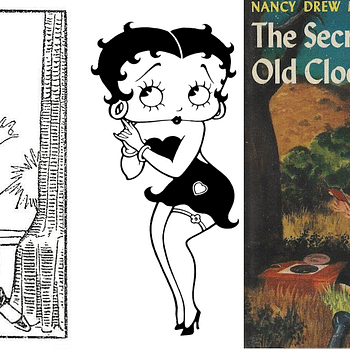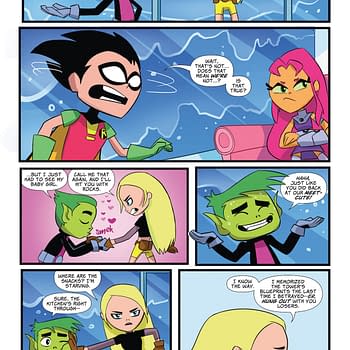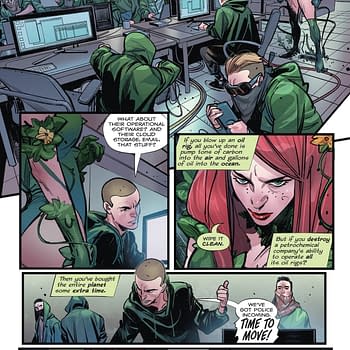Posted in: Comics, Recent Updates | Tagged: heroescon, hulk, jim steranko, marvel
How Jim Steranko Created *That* Hulk Cover…
Making his first visit to the Heroes Con and, apparently, his first ever visit to the state of North Carolina, Jim Steranko delighted fans who attended his Saturday afternoon panel. This well-attended session, moderated by J.D. Spurlock, who gave quite a rousing introduction, served as an opportunity for Steranko to reflect on his career and share several of his favorite memories. While some of his stories may have been familiar to those who know Steranko and his work, there were others that offered fascinating insights into both his personality and his art.
Perhaps most surprising was the considerable time Steranko spent discussing his early family life in Pennsylvania. At several points during these comments, Steranko paused and had to prevent his emotions from getting the better of him. He spoke at length about his difficult childhood, noting that his family was poor and that his father did not support his love of comics and drawing. His mother, however, seemed to be more supportive, and Steranko noted that she taught him to read at a very young age by using old comics given to the family by his uncle. He also explained that it was as a child that he began to keep his well-known late hours, since it was only possible for him to draw after his family had gone to sleep. The family's humble circumstances also made it hard for him to find the art supplies he needed, and so as a boy, Steranko often sketched on the back of bills and other mail the family received.
Steranko also described his troubles with a local gang (the Bear Park Racers) while in high school. These bullies harassed him every day on his way to and from school, and they often beat him up badly. Tired of being attacked by the gang, as well as frustrated and embarrassed by the questions he received from his family at home, Steranko began to visit his local YMCA where he took up boxing. This training helped him defend himself, but by his own telling, it was not enough to stop the gang's constant attacks. His story ended rather ominously with him building a zip gun in shop class and confronting each of the gang members individually at their homes. Only then, he said, did they finally leave him alone.
No one in the audience could leave the session without recognizing Steranko's remarkable work ethic. As he transitioned from his childhood into a retelling of his entry into the comics world as a young man, he noted that he was holding down two full time jobs at the time (art director at an advertising agency and guitarist in a rock band). In recounting this story, and his hiring by Stan Lee at Marvel, he mentioned how it was that he came to work on Nick Fury. Told by Lee that he could pick any book that Marvel published to work on, he looked at the rack of Marvel's offerings and decided on Strange Tales. He picked the worst selling book Marvel had feeling confident that he could take it nowhere else but up. "I might be crazy, but I'm not stupid," Steranko noted, in summing up his choice.
One of the most interesting stories Steranko shared came near the end of the panel, when he recounted the creation of one his most iconic covers: the Incredible Hulk Annual #1. The cover to this annual, it seemed, had fallen through the cracks at Marvel and needed to be completed immediately. Steranko accepted the assignment late one afternoon and agreed to an 8am deadline the next morning. He knew it was a potentially dangerous job when he asked what should appear on the cover and was told by the editor that he didn't care. Working through the night, he finished the cover and had to drive in to the city and submit it at the Marvel offices in Manhattan. On the way, Steranko decided that he should look sharp, and he began to give himself a dry shave in the car. Sitting in traffic and shaving, his car was bumped from behind by another driver. As a result, Steranko cut himself rather badly and began to bleed profusely. Nevertheless, he double-parked outside the Marvel offices, went inside, and turned his work in on time — bleeding all the while. The end of his story, in which he noted that he had really given Marvel blood, sweat and tears on this cover, got quite a laugh.
Unfortunately, the panel ended without any time for questions from the audience, but most seemed satisfied that they had been given a rare glimpse into Steranko as a person and artist. Touted as "comics' first rock star" during Spurlock's introduction, Steranko nevertheless came across as a hard-working and dedicated artist from humble origins who made good despite the odds against him. The "rock star" image will undoubtedly hold — aided by Steranko himself — but it felt good to walk out of the panel knowing more about the man behind the myth.
Brian M. Puaca is an associate professor of history at Christopher Newport University in Newport News, Virginia, where he teaches a course on the history of comic books and American culture. He can be reached at bpuaca@cnu.edu.

















